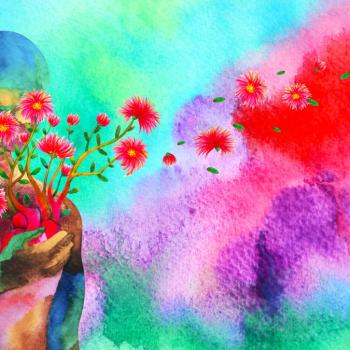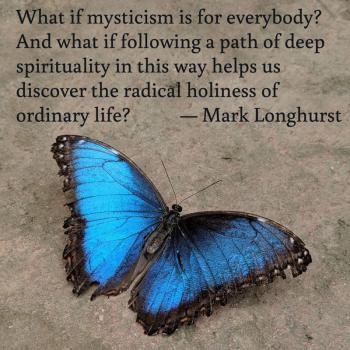Recently on social I media I offered this observation:
My online friend James Ishmael Ford, author of books like Introduction to Zen Koans and Zen Master Who?, reposted it to his timeline, dutifully crediting me as the source.
I was surprised — and a bit bemused — by the response.
James is a retired UU minister and a Zen priest (he also has a wonderful blog here on Patheos). So it’s only natural that his readers come at religion — and science, and poetry — from a different perspective than I do. Nevertheless, it intrigued me that several people pushed back at what I thought was a pretty non-controversial statement.
One response seemed rather silly:
Just as I thought: nobody knows what religion is & everybody is an expert.
But others genuinely disagreed with my suggestion that religion should not be equated with science:
For myself religion is definitely both. Come to think of it, I have even referred to my holy texts as lab manuals more than once.
One person helpfully suggested that I should try approaching religion like an experiment:
Supposing you treated it like a science project: test out this set of teachings to see if it yields reproducible results. It’s what I did, and I would venture that it’s just as valid as poetry night.
Thankfully, no one was trollish, and so yet again social media functions like a teacher. I regularly need be reminded how diverse we all are, and this was yet another lesson.
But today I’m going to double down a bit. I think it’s a mistake to nudge religion toward science and away from poetry. I know that will annoy some people, but I invite you to hear me out.
Equating Religion with Science does a Disservice to Both
 Like most non-fundamentalist persons of faith, I appreciate and value the many blessings that science bestows on humankind. I would not want to go back to a world where faith dictates what we can and cannot know, what we can and cannot study, or how we approach the investigation of everything from biology to psychology to astrophysics.
Like most non-fundamentalist persons of faith, I appreciate and value the many blessings that science bestows on humankind. I would not want to go back to a world where faith dictates what we can and cannot know, what we can and cannot study, or how we approach the investigation of everything from biology to psychology to astrophysics.
In short, I accept and fully affirm the notion that science gives us concrete, verifiable knowledge about the world we live in. Religion, meanwhile, offers us a sense of meaning, of purpose, and helps to give a mythical and poetic framework for approaching the mysteries of life (both good and bad: death, suffering, love, injustice/justice, and so forth). Science, at its best, and religion, likewise at its best, can cooperate beautifully to fill life with reliable knowledge, meaningful wisdom, and a map for thriving both physically and spiritually.
Yes, I know there is a sorry history of hostility toward science on the part of some religionists. And nowadays we have militant atheists who are returning the favor. But you don’t judge a piano on the basis of someone who can’t play it very well. Religion should be measured by the saints it produces, not by the sinners who refuse to embrace its wisdom. Likewise, science must be measured by the knowledge it unearths, and not by its own problems of dogmatic or politically-biased thinking.
So, then, why not approach religion like a science experiment?
Because it just doesn’t work.
The scientific method promises verifiable results based on consistent conditions and systems of measurement. But how can one measure the soul? Or the presence of God? How can we create “consistent conditions” for meditation or interior exploration, when wisdom and understanding are continually evolving? How can I know that what you say about your experience of God, or enlightenment, or meaning, is true? I can’t go out and “reproduce the experiment” — because I’m a different person, with a different soul, a different story, a different set of virtues and vices, wounds and gifts.
To attempt to reduce religion to a scientific experiment is to try to domesticate the human spirit — or, worse, to insist that there is no spirit, that we are essentially biological mechanisms, and nothing more.
Even something as prosaic and natural as interior silence eludes the careful calibration of measurement. On the outside, we have good tools for document decibel levels — as I write these words, the decibel level in my office is about 54 dB — thanks to the clicking of my keyboard, the hum of my heat pump, and the whirr of my computer’s fan. It’s easily measured with an app on my phone. But there is no app to plumb the quality of depth of the silence in our hearts.
Look, I get it that the idea of reducing religion to a verifiable experiment has its allure, especially since we live in a scientific age and so many of us are annoyed at how much dogmatic thinking and attempts at spiritual coercion lurk in the minds of many religious adherents. But the solution to bad religion is not science — it’s good religion.
Trying to make religion submit to the process of scientific inquiry is to try to reduce it to a mere technology of the soul, a kind of psychological “app” that comes in handy whenever we need to manage difficult emotions (guilt, remorse, fear of death, etc.) or optimize the good ones (awe, wonder, peace, joy, and so forth). It’s a form of aggression against religion, insisting that it can be subject to human control, to our individual efforts to manage our lives and our environments.
This kind of aggression leaves no room for God or for the soul or for mystery — it either insists that each of these is a fiction, or else it assumes that they are actually manageable phenomena rather than awe-inspiring encounters with the numinous.
Religion is not a technology for making our lives better. It is an encounter with mystery that invites us into wisdom, meaning, and relationship. Religion offers us resources that, indeed, can make our lives better. But we are never fully in the driver’s seat, even when embracing such spiritual “tools.”
Of the Distinction between Technique and Method
This brings me back to the wonderful series of questions I received about centering prayer a while back from an Episcopal priest (you can read the full message here). The priest wrote about his concerns that centering prayer and other forms of Christian meditation are approached as mere “techniques” for prayer.
Both schools of centering prayer and Christian meditation, inspired by Dom Main, seem to instrumentalize what can’t be spoken of or performed as technique — relationship with Christ. I worry that in making contemplation approachable we turn it into a technique and then begin to quibble over the merits of whatever school we are aligned with. That the quibbling also results in book sales/website hits is another more cynical concern of mine.
As some one who has gone through the training to be a centering prayer teacher, I can attest that this was drilled into our heads: “centering prayer is not a technique, it is a method.”
But what’s the difference?
I think my reader helps to unpack that question with his word “instrumentalize.”
When centering prayer, or Christian meditation, or any other spiritual practice, are used in an instrumental way — which is to say, using the practice for the express purpose of achieving a specific and pre-determined personal/individual outcome — then the practices are being used as “spiritual techniques.”
In other words, if you are using centering prayer just to feel more peaceful, or to try to have a mystical experience, or to make God speak to you, then you using centering prayer as a kind of spiritual technology. You’ve reduced it to a mere tool for managing your inner life.
This is an abuse of centering prayer. Or, at the very least, it is a misuse or perhaps a misunderstanding that diminishes what centering prayer truly is.
I don’t mean to be shaming people — I imagine the vast majority of people who approach centering prayer in this instrumental way or not doing it maliciously; they have not been properly formed in the spirituality of contemplation, and of course we all live in a world that tries to interact with everything in terms of dominance, control, and instrumentality — so no wonder many practitioners of centering prayer make this mistake.
So when we call centering prayer a method rather than a technique, it is a subtle but important reminder that centering prayer is meant to be a process rather than a tool. The point behind centering prayer is to foster and deepen our relationship with God. It is a relational practice rather than an instrumental one.
Everyone knows that in the realm of human relationships, it’s wrong to “use” people. We can use another person for sexual gratification, or for indulging in unhealthy psychological dynamics, or for exploitation in the interest of financial gain or some other personal advantage. It’s just plain wrong to use another person, and everyone knows it (even if, in our culture, we often give one another a free pass).
Well, to the extent that we use centering prayer (or any other spiritual practice) as a technique for managing how God interacts with us, we are in the business of using God. God loves us anyway, but it’s a sad way to respond to that love.
So the next time you hear a centering prayer person say that contemplation is a method and not a technique, remember what they’re saying: it’s an invitation into a relationship with God, a sovereign God who cannot be manipulated or controlled. To use it as a technique is to squander that invitation into love, settling instead for mere psychological self-help (emphasis on “self”).
I agree with my Episcopal priest friend: it’s sad when even well-meaning people turn a spiritual practice into a spiritual technology. But the solution to that, of course, is to keep calling ourselves back to where the heart of spirituality invites us.
Which brings me back to poetry.
Yes, religion is much more like a poetry reading than a science experiment
This post is already way too long, so I’m going to keep this brief. Why do I compare religion favorably to poetry, after suggesting it’s a mistake to equate religion and science?
It’s been said that all poetry ultimately ushers us to the threshold of just one or two mysteries: love, and death.
And love and death are the domains of religion as well.
Religion, at its best, is a love poem. A love poem involving you, and me, and all people, and all creation, and — at least for theistic religions — God, and the angels, and ancestors, and the saints in heaven.
Like any love story, it has its share of conflict, of misunderstandings and mistakes, of love resisted and rejected as well as love embraced and celebrated.
But the love poem never ends. There’s always a new verse, a new word, a new image and invitation and possibility.
The Bible, the Qur’an, the Bhagavad Gita, the Heart Sutra, so many sacred texts around the world shimmer with poetry. These are songs and canticles to inspire the imagination, for the cultivation of wonder, for rediscovering what is possible, for the fostering of meaning and love. Yes, I know religious language can frighten rather than inspire, can shame rather than encourage, can stultify rather than liberate. But there’s that drama in the love story — because at its best, religion corrects itself and continually calls us forward into deeper understanding and a fuller appreciation of what is possible when we lived grounded in love and wonder.
I know poetry drives some people crazy. But guess what? God drives some people crazy too. Maybe we need a little but more of this kind crazy in our lives — a “crazy” grounded in unknowing, in realizing “we’re not in control,” in the humbling recognition that we all need one another — to understand religion (!), and to get through the week, and finally to live life well, filled with love and purpose.
So to all of you who insist that religion should be a science experiment: I wish you well. But honestly: I think you’re missing out on something far, far better. Immerse yourself in the love poem: your life will be transformed.
Enjoy reading this blog?
Click here to become a patron.














